《英语修辞》作业
- 格式:doc
- 大小:87.50 KB
- 文档页数:11
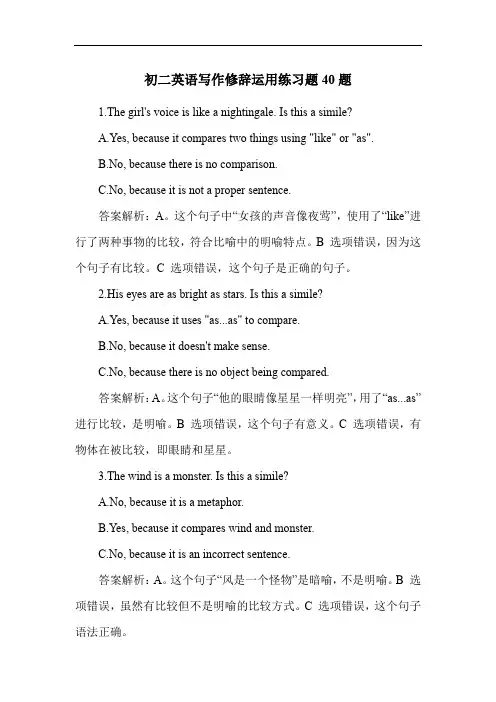
初二英语写作修辞运用练习题40题1.The girl's voice is like a nightingale. Is this a simile?A.Yes, because it compares two things using "like" or "as".B.No, because there is no comparison.C.No, because it is not a proper sentence.答案解析:A。
这个句子中“女孩的声音像夜莺”,使用了“like”进行了两种事物的比较,符合比喻中的明喻特点。
B 选项错误,因为这个句子有比较。
C 选项错误,这个句子是正确的句子。
2.His eyes are as bright as stars. Is this a simile?A.Yes, because it uses "as...as" to compare.B.No, because it doesn't make sense.C.No, because there is no object being compared.答案解析:A。
这个句子“他的眼睛像星星一样明亮”,用了“as...as”进行比较,是明喻。
B 选项错误,这个句子有意义。
C 选项错误,有物体在被比较,即眼睛和星星。
3.The wind is a monster. Is this a simile?A.No, because it is a metaphor.B.Yes, because it compares wind and monster.C.No, because it is an incorrect sentence.答案解析:A。
这个句子“风是一个怪物”是暗喻,不是明喻。
B 选项错误,虽然有比较但不是明喻的比较方式。
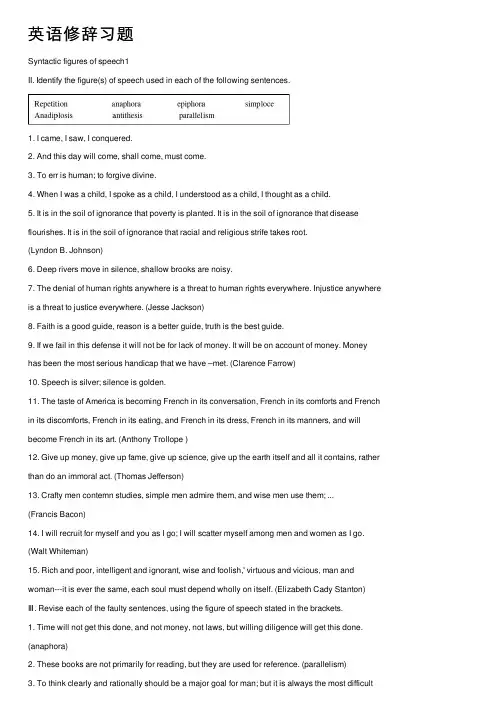
英语修辞习题Syntactic figures of speech1II. Identify the figure(s) of speech used in each of the following sentences.1. I came, I saw, I conquered.2. And this day will come, shall come, must come.3. To err is human; to forgive divine.4. When I was a child, I spoke as a child, I understood as a child, I thought as a child.5. It is in the soil of ignorance that poverty is planted. It is in the soil of ignorance that disease flourishes. It is in the soil of ignorance that racial and religious strife takes root.(Lyndon B. Johnson)6. Deep rivers move in silence, shallow brooks are noisy.7. The denial of human rights anywhere is a threat to human rights everywhere. Injustice anywhere is a threat to justice everywhere. (Jesse Jackson)8. Faith is a good guide, reason is a better guide, truth is the best guide.9. If we fail in this defense it will not be for lack of money. It will be on account of money. Money has been the most serious handicap that we have –met. (Clarence Farrow)10. Speech is silver; silence is golden.11. The taste of America is becoming French in its conversation, French in its comforts and French in its discomforts, French in its eating, and French in its dress, French in its manners, and will become French in its art. (Anthony Trollope )12. Give up money, give up fame, give up science, give up the earth itself and all it contains, rather than do an immoral act. (Thomas Jefferson)13. Crafty men contemn studies, simple men admire them, and wise men use them; ... (Francis Bacon)14. I will recruit for myself and you as I go; I will scatter myself among men and women as I go. (Walt Whiteman)15. Rich and poor, intelligent and ignorant, wise and foolish,' virtuous and vicious, man and woman---it is ever the same, each soul must depend wholly on itself. (Elizabeth Cady Stanton)Ⅲ. Revise each of the faulty sentences, using the figure of speech stated in the brackets.1. Time will not get this done, and not money, not laws, but willing diligence will get this done. (anaphora)2. These books are not primarily for reading, but they are used for reference. (parallelism)3. To think clearly and rationally should be a major goal for man; but it is always the most difficultfor man to think clearly and rationally. (simploce)4. He was a miser, a bachelor, and he is an egoist. (parallelism)5. Adversity and struggle lie at the root of evolutionary progress. Adversity forms pressure, and change is brought by pressure. (anadiplosis)6. Gary is not a good track man, and neither is his swimming. (parallelism)7. When you know a thing, do hold that you know it, and if you do not know it, admit that you do not----this is true knowledge. (anaphora)8. And then suddenly the machines pushed them out and they swarmed on the highways.Themovement changed them; the highways, the camps along the road, the fear of hunger and the hunger itself, changed them. The children without dinner changed them, they were changed by the endless moving. They were migrants. And the hostility changed them, welded them, united them... (epiphora)Syntactic figures of speech 2Ⅱ. Identify the figures of speech used in each of the following sentences.1. He caught a bus and a cold.2. I honored him, I trusted him, and I loved him.3. The wolf may lose his teeth, but never his nature4. His fair hair and play attracted the cadres.5. Are they not typical international robbers and pirates?6. Simon is a great statesman, a great warrior, a great poet, and a skilled performer onthe harp.7. A miser grows rich by seeming poor. An extravagant man grows poor by seemingrich. (Reader's Digest)8.“( Confidence) thrives only on honesty, on honor, on the sacredness of obligations,on faithful protection, on unselfish performance; without them it cannot live.” (F. Roosevelt)9. His acquaintances, his friends and even his family tamed against him, the traitor.10. One describes the glory of the English Queen,And one describes a charming Indian screen. (A. Pope)11. The man is not rich because he is honest, but he is honest because he is rich(Defoe)12. We do not retreat. We are not content to stand still. As Americans, we go forward,in the service of our country, by the will of God. (F. Roosevelt)13. Ten minutes later, the coffee and Commander Dana of Naval Intelligence arrived simultaneously.14. They may love or hate or admire or fear or envy this country. (J. Baldwin)15. Shall we pause now and turn our back upon the road that lies ahead? Shall we call this the promised land? Or, shall we continue on our way? (F. Roosevelt)Ⅲ. Point out the syllepsis used in each of the following sentences. Explain how the governing word (or phrase) is used both literally and figuratively in the sentence.1. She made up her mind and her face.2. Piano, a parlor utensil for subduing the impenitent visitor, is operated by depressing the keys of the machine and the spirits of the audience.3. McHade advised us to keep our public image intact and our students in their seats.4. He possessed two false teeth and a sympathetic heart.5. She looked at the faded photo with suspicion and a magnifying glass.6. The newly elected member for Central Leeds took the oath and his seat.IV . Zeugma is employed in each of the following sentences. First identifythe。

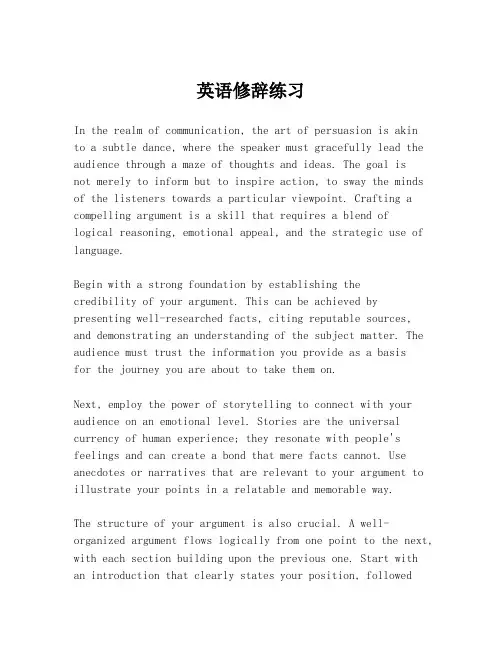
英语修辞练习In the realm of communication, the art of persuasion is akinto a subtle dance, where the speaker must gracefully lead the audience through a maze of thoughts and ideas. The goal isnot merely to inform but to inspire action, to sway the minds of the listeners towards a particular viewpoint. Crafting a compelling argument is a skill that requires a blend oflogical reasoning, emotional appeal, and the strategic use of language.Begin with a strong foundation by establishing thecredibility of your argument. This can be achieved by presenting well-researched facts, citing reputable sources, and demonstrating an understanding of the subject matter. The audience must trust the information you provide as a basisfor the journey you are about to take them on.Next, employ the power of storytelling to connect with your audience on an emotional level. Stories are the universal currency of human experience; they resonate with people's feelings and can create a bond that mere facts cannot. Use anecdotes or narratives that are relevant to your argument to illustrate your points in a relatable and memorable way.The structure of your argument is also crucial. A well-organized argument flows logically from one point to the next, with each section building upon the previous one. Start with an introduction that clearly states your position, followedby the body of your argument where you present your main points, and conclude with a summary that reinforces your stance and calls to action.Ethos, pathos, and logos—the three pillars of persuasion—are your allies in this endeavor. Ethos appeals to the character and credibility of the speaker, pathos taps into the emotions of the audience, and logos relies on logical reasoning. Balancing these elements can create a persuasive argument that is both intellectually convincing and emotionally engaging.Use rhetorical devices such as repetition, parallelism, and rhetorical questions to enhance the impact of your speech. These tools can emphasize key points, create a sense of rhythm, and provoke thought in your audience.Finally, be mindful of your audience. Tailor your language, tone, and approach to suit the demographic and cultural background of your listeners. Understanding their values, concerns, and preconceived notions can help you craft an argument that is not only persuasive but also resonates with them on a personal level.In conclusion, the art of persuasion is a multifaceted craft that requires a deep understanding of both the subject matter and the audience. By combining logical reasoning with emotional appeal and strategic language use, one can craft an argument that not only persuades but also leaves a lasting impression.。
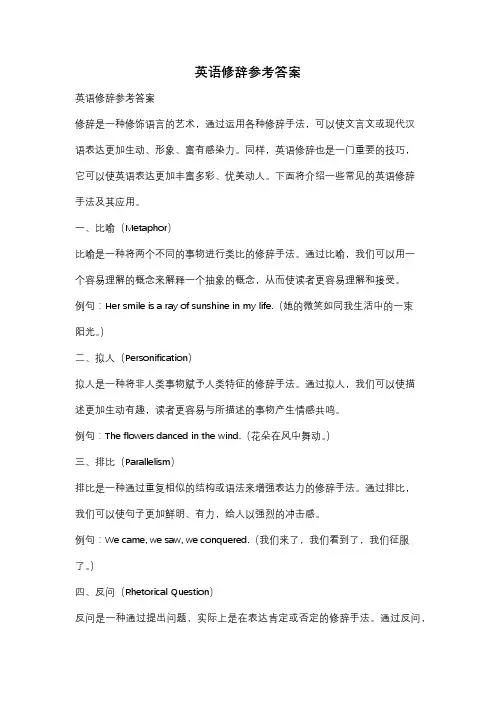
英语修辞参考答案英语修辞参考答案修辞是一种修饰语言的艺术,通过运用各种修辞手法,可以使文言文或现代汉语表达更加生动、形象、富有感染力。
同样,英语修辞也是一门重要的技巧,它可以使英语表达更加丰富多彩、优美动人。
下面将介绍一些常见的英语修辞手法及其应用。
一、比喻(Metaphor)比喻是一种将两个不同的事物进行类比的修辞手法。
通过比喻,我们可以用一个容易理解的概念来解释一个抽象的概念,从而使读者更容易理解和接受。
例句:Her smile is a ray of sunshine in my life.(她的微笑如同我生活中的一束阳光。
)二、拟人(Personification)拟人是一种将非人类事物赋予人类特征的修辞手法。
通过拟人,我们可以使描述更加生动有趣,读者更容易与所描述的事物产生情感共鸣。
例句:The flowers danced in the wind.(花朵在风中舞动。
)三、排比(Parallelism)排比是一种通过重复相似的结构或语法来增强表达力的修辞手法。
通过排比,我们可以使句子更加鲜明、有力,给人以强烈的冲击感。
例句:We came, we saw, we conquered.(我们来了,我们看到了,我们征服了。
)四、反问(Rhetorical Question)反问是一种通过提出问题,实际上是在表达肯定或否定的修辞手法。
通过反问,我们可以引起读者的思考,增加文章的说服力。
例句:Are we not all humans?(难道我们不都是人类吗?)五、夸张(Hyperbole)夸张是一种通过夸大事物的程度或规模来增强效果的修辞手法。
通过夸张,我们可以使表达更加生动有趣,引起读者的共鸣。
例句:I've told you a million times not to do that!(我已经告诉你一百万次不要这样做了!)六、比较(Simile)比较是一种通过使用"like"或"as"来将两个不同的事物进行比较的修辞手法。
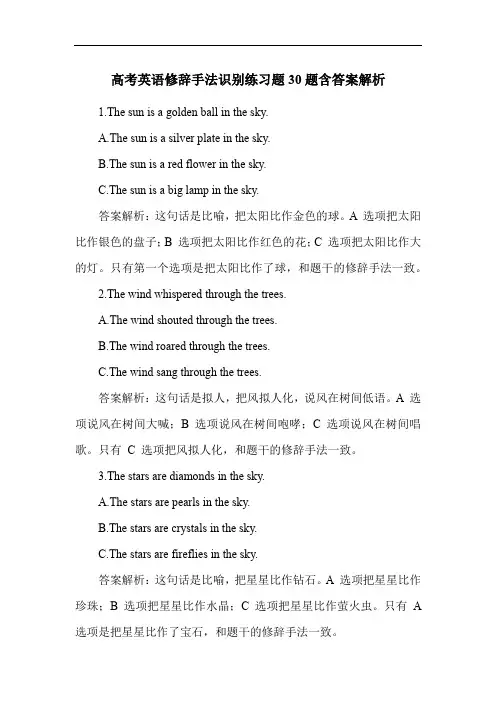
高考英语修辞手法识别练习题30题含答案解析1.The sun is a golden ball in the sky.A.The sun is a silver plate in the sky.B.The sun is a red flower in the sky.C.The sun is a big lamp in the sky.答案解析:这句话是比喻,把太阳比作金色的球。
A 选项把太阳比作银色的盘子;B 选项把太阳比作红色的花;C 选项把太阳比作大的灯。
只有第一个选项是把太阳比作了球,和题干的修辞手法一致。
2.The wind whispered through the trees.A.The wind shouted through the trees.B.The wind roared through the trees.C.The wind sang through the trees.答案解析:这句话是拟人,把风拟人化,说风在树间低语。
A 选项说风在树间大喊;B 选项说风在树间咆哮;C 选项说风在树间唱歌。
只有C 选项把风拟人化,和题干的修辞手法一致。
3.The stars are diamonds in the sky.A.The stars are pearls in the sky.B.The stars are crystals in the sky.C.The stars are fireflies in the sky.答案解析:这句话是比喻,把星星比作钻石。
A 选项把星星比作珍珠;B 选项把星星比作水晶;C 选项把星星比作萤火虫。
只有 A 选项是把星星比作了宝石,和题干的修辞手法一致。
4.The river danced its way to the sea.A.The river flowed its way to the sea.B.The river rushed its way to the sea.C.The river skipped its way to the sea.答案解析:这句话是拟人,把河流拟人化,说河流跳舞着流向大海。
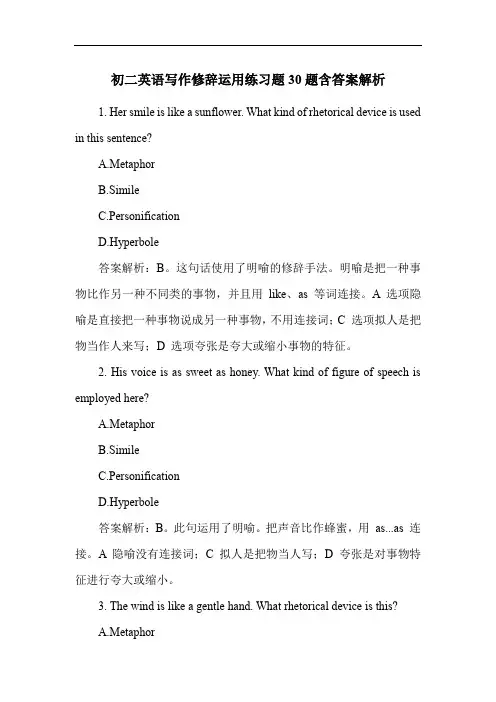
初二英语写作修辞运用练习题30题含答案解析1. Her smile is like a sunflower. What kind of rhetorical device is used in this sentence?A.MetaphorB.SimileC.PersonificationD.Hyperbole答案解析:B。
这句话使用了明喻的修辞手法。
明喻是把一种事物比作另一种不同类的事物,并且用like、as 等词连接。
A 选项隐喻是直接把一种事物说成另一种事物,不用连接词;C 选项拟人是把物当作人来写;D 选项夸张是夸大或缩小事物的特征。
2. His voice is as sweet as honey. What kind of figure of speech is employed here?A.MetaphorB.SimileC.PersonificationD.Hyperbole答案解析:B。
此句运用了明喻。
把声音比作蜂蜜,用as...as 连接。
A 隐喻没有连接词;C 拟人是把物当人写;D 夸张是对事物特征进行夸大或缩小。
3. The wind is like a gentle hand. What rhetorical device is this?A.MetaphorC.PersonificationD.Hyperbole答案解析:B。
这句话是明喻。
把风比作温柔的手,有连接词like。
A 隐喻是直接说一种事物是另一种事物;C 拟人是赋予物人的特点;D 夸张是夸大事物特征。
4. Her eyes are stars. What figure of speech is used?A.MetaphorB.SimileC.PersonificationD.Hyperbole答案解析:A。
这是隐喻。
直接把眼睛说成星星,没有连接词。
B 明喻有连接词;C 拟人是把物当人写;D 夸张是夸大事物特点。
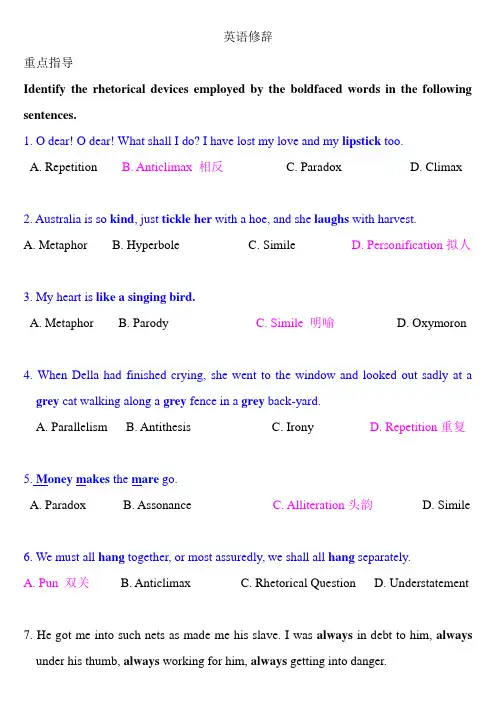
英语修辞重点指导Identify the rhetorical devices employed by the boldfaced words in the following sentences.1. O dear! O dear! What shall I do? I have lost my love and my lipstick too.A. RepetitionB. Anticlimax 相反C. ParadoxD. Climax2. Australia is so kind, just tickle her with a hoe, and she laughs with harvest.A. MetaphorB. HyperboleC. SimileD. Personification拟人3. My heart is like a singing bird.A. MetaphorB. ParodyC. Simile 明喻D. Oxymoron4. When Della had finished crying, she went to the window and looked out sadly at a grey cat walking along a grey fence in a grey back-yard.A. ParallelismB. AntithesisC. IronyD. Repetition重复5. Money makes the mare go.A. ParadoxB. AssonanceC. Alliteration头韵D. Simile6. We must all hang together, or most assuredly, we shall all hang separately.A. Pun 双关B. AnticlimaxC. Rhetorical QuestionD. Understatement7. He got me into such nets as made me his slave. I was always in debt to him, always under his thumb, always working for him, always getting into danger.A. MetonymyB. ClimaxC. HyperboleD. Repetition8. He sat there and watched them, so changelessly changing, so bright and dark, so grave and gay.A. MetaphorB. HyperboleC. SimileD. Oxymoron9. It was not anger, nor surprise, nor disapproval, nor horror, nor any of the emotions that she had been prepared for.A. AnastropheB. ParallelismC. ZeugmaD. Antithesis10. The cheque fluttered to the floor like a bird with a broken wing.A. MetaphorB. SimileC. HyperboleD. Oxymoron11. There was an audible stillness,(可以听的到的安静)in which the common voice sounded strange.A. MetaphorB. HyperboleC. SimileD. Oxymoron相反12. Praise is like sunlight to the human spirit we cannot flower and grow without it.A. MetaphorB. HyperboleC. SimileD. Oxymoron13. One teacher writes that instead of drowning students’compositions in critical redink, the teacher will get far more constructive results by finding one or two things which have been done better than last time, and commenting favorably on them.A. ParallelismB. Transferred EpithetC. AlliterationD. Metaphor14. He looked at me with a bitter look.A. SynaesthesiaB. AntithesisC. OxymoronD. Metaphor15. I wish I could write better.A. PunB. HyperboleC. ClimaxD. Understatement16. And, it being low water he went out with the tide.A. MetaphorB. HyperboleC. EuphemismD. Parallelism17. Fame and gain I don’t care.A. AnastropheB. HyperboleC. SimileD. Pun18. England won the football game.A. MetaphorB. HyperboleC. SimileD. Synecdoche提喻19. Love, sometimes, is a kind of sweet torment.A. AnticlimaxB. OxymoronC. ClimaxD. Pun "More haste, less speed" is aparadox."欲速则不达"是似非而是的隽语。
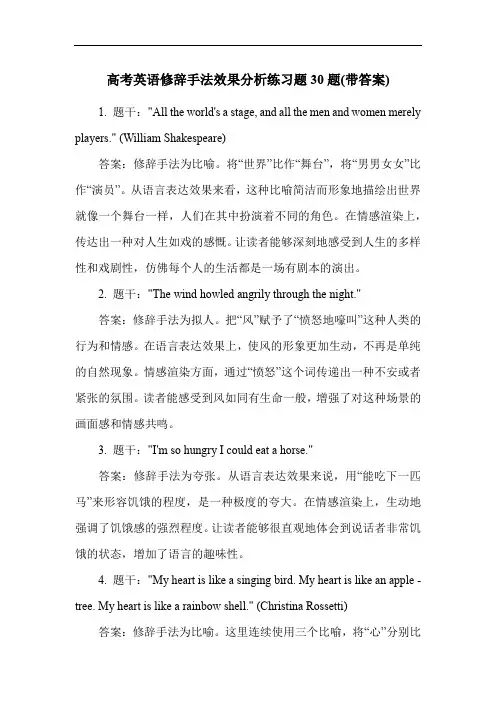
高考英语修辞手法效果分析练习题30题(带答案)1. 题干:"All the world's a stage, and all the men and women merely players." (William Shakespeare)答案:修辞手法为比喻。
将“世界”比作“舞台”,将“男男女女”比作“演员”。
从语言表达效果来看,这种比喻简洁而形象地描绘出世界就像一个舞台一样,人们在其中扮演着不同的角色。
在情感渲染上,传达出一种对人生如戏的感慨。
让读者能够深刻地感受到人生的多样性和戏剧性,仿佛每个人的生活都是一场有剧本的演出。
2. 题干:"The wind howled angrily through the night."答案:修辞手法为拟人。
把“风”赋予了“愤怒地嚎叫”这种人类的行为和情感。
在语言表达效果上,使风的形象更加生动,不再是单纯的自然现象。
情感渲染方面,通过“愤怒”这个词传递出一种不安或者紧张的氛围。
读者能感受到风如同有生命一般,增强了对这种场景的画面感和情感共鸣。
3. 题干:"I'm so hungry I could eat a horse."答案:修辞手法为夸张。
从语言表达效果来说,用“能吃下一匹马”来形容饥饿的程度,是一种极度的夸大。
在情感渲染上,生动地强调了饥饿感的强烈程度。
让读者能够很直观地体会到说话者非常饥饿的状态,增加了语言的趣味性。
4. 题干:"My heart is like a singing bird. My heart is like an apple - tree. My heart is like a rainbow shell." (Christina Rossetti)答案:修辞手法为比喻。
这里连续使用三个比喻,将“心”分别比作“唱歌的鸟”“苹果树”“彩虹贝壳”。
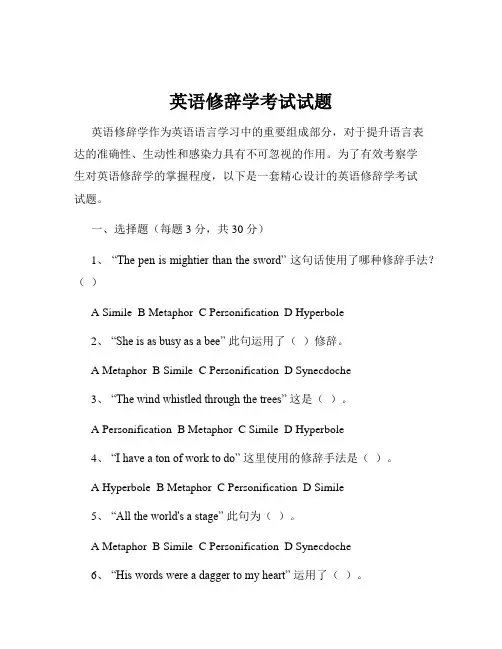
英语修辞学考试试题英语修辞学作为英语语言学习中的重要组成部分,对于提升语言表达的准确性、生动性和感染力具有不可忽视的作用。
为了有效考察学生对英语修辞学的掌握程度,以下是一套精心设计的英语修辞学考试试题。
一、选择题(每题 3 分,共 30 分)1、“The pen is mightier than the sword” 这句话使用了哪种修辞手法?()A SimileB MetaphorC PersonificationD Hyperbole2、“She is as busy as a bee” 此句运用了()修辞。
A MetaphorB SimileC PersonificationD Synecdoche3、“The wind whistled through the trees” 这是()。
A PersonificationB MetaphorC SimileD Hyperbole4、“I have a ton of work to do” 这里使用的修辞手法是()。
A HyperboleB MetaphorC PersonificationD Simile5、“All the world's a stage” 此句为()。
A MetaphorB SimileC PersonificationD Synecdoche6、“His words were a dagger to my heart” 运用了()。
A SimileB MetaphorC PersonificationD Hyperbole7、“The stars danced playfully in the sky” 属于()。
A PersonificationB MetaphorC SimileD Hyperbole8、“The child is the father of the man” 是()。
A MetaphorB SimileC PersonificationD Oxymoron9、“Not a single word was spoken” 此句中使用的修辞是()。
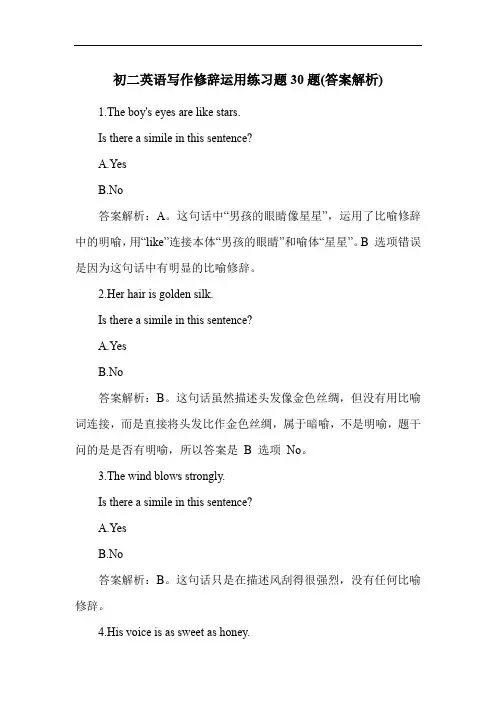
初二英语写作修辞运用练习题30题(答案解析)1.The boy's eyes are like stars.Is there a simile in this sentence?A.YesB.No答案解析:A。
这句话中“男孩的眼睛像星星”,运用了比喻修辞中的明喻,用“like”连接本体“男孩的眼睛”和喻体“星星”。
B 选项错误是因为这句话中有明显的比喻修辞。
2.Her hair is golden silk.Is there a simile in this sentence?A.YesB.No答案解析:B。
这句话虽然描述头发像金色丝绸,但没有用比喻词连接,而是直接将头发比作金色丝绸,属于暗喻,不是明喻,题干问的是是否有明喻,所以答案是B 选项No。
3.The wind blows strongly.Is there a simile in this sentence?A.YesB.No答案解析:B。
这句话只是在描述风刮得很强烈,没有任何比喻修辞。
4.His voice is as sweet as honey.Is there a simile in this sentence?A.YesB.No答案解析:A。
“他的声音像蜂蜜一样甜”,用“as...as”连接本体“他的声音”和喻体“蜂蜜”,是明喻。
5.The sun shines brightly.Is there a simile in this sentence?A.YesB.No答案解析:B。
这句话只是在描述太阳明亮地照耀着,没有比喻修辞。
6.Her smile is like a flower.Is there a simile in this sentence?A.YesB.No答案解析:A。
“她的微笑像一朵花”,用“like”连接本体“她的微笑”和喻体“花”,是明喻。
7.The tree is very tall.Is there a simile in this sentence?A.YesB.No答案解析:B。
高级英语第2册修辞练习第1课Point the rhetorical devices used in the following sentencescan batten down and ride it out. (Metaphor )and rain now whipped the house. ( Metaphor )away from the windows. (Elliptical sentence )the rain seemingly driven right through the walls. ( Simile )8:30, power failed. (Metaphor )out the back door to the cars. (Elliptical sentence ) children went from adult to adult like buckets in a fire brigade. ( Simile )8…the electrical systems had been killed by water.( metaphor )on the stairs. ( elliptical sentence )wind sounded like the roar of a train passing a few yards away. ( simile )11. A moment later, the hurricane, in one mighty swipe, lifted the entire roof off the house and skimmed it 40 feet though the air. ( personification )12…it seized a 600,000-gallon Gulfport oil tank and dumped it miles away. ( personification )poles and 20-inch-thick pines cracked like guns as the windssnapped them.( simile )vacationers at the luxurious Richelieu Apartments there held a hurricane party to watch the storm from their spectacular vantage point. ( Transferred epithet )15. Up the stairs --- into our bedroom. ( Elliptical sentence )world seemed to be breaking apart. ( Simile )17. Water inched its way up the steps as first floor outside walls collapsed. (Metaphor )of clothing festooned the standing trees.. (Metaphor ) 19…and blown-down power lines coiled like black spaghetti over the road.( simile )20…household and medical supplies streamed in by plane, train, truck and car. (metaphor ), meanwhile, had raked its way northward across Mississippi, dropped more than 28 inches of rain into West.( metaphor )高级英语第2册修辞练习第2课Put out the rhetorical devices used in the following sentences 1.The burying-ground is merely a huge waste of hummocky earth, like a derelict building-lot.( simile )really the same flesh as yourself (rhetorical question )3. Do they even have names (rhetorical question )4. Or are they merely a kind of undifferentiated brown stuff, about as individual as bees or coral insects ( rhetorical question )5. …and then they sin k back into the nameless mounds of the graveyard and nobody notices that they are gone. ( euphemism )6….sore-eyed children cluster everywhere in unbelievable numbers, like clouds of flies. (simile )7. In the bazaar huge families of Jews, all dressed in the long-black robe and little black skull-cap, are working in dark fly-infested booths that look like caves. (simile )8. Instantly, from the dark holes all round, there was a frenziedrush of Jews…. ( transferred )9. Still, a white skin is always fairly conspicuous. ( synecdoche )10. What does Morocco mean to a Frenchman An orange grove or a job in Government service ( elliptical sentence )an Englishman Camels, castles, palm trees, Foreign Legionnaires, brass trays, and bandits.( )12. Long lines of women, bent double like inverted capital Ls, work their way slowly across the fields,… ( simile )13. All of them are mummified with age and the sun, and all of them are tiny. ( metaphor )14. This kind of thing makes one’s blood boil,..(hyperbole )15. How much longer can we go on kidding these people How long before they turn their guns in the other direction ( rhetorical question )16. And really it was like watching a flock of cattle to see the long column, a mile or two miles of armed men,… ( simile )17…while the great white birds drifted over them in the opposite direction, glittering like scraps of paper. ( simile ) 18. But there is one thought which every white man thinks when hesees a black army marching past…Every white man there had this thought …I had it, so had the other onlookers, so had the officers on their sweating chargers and the white .Os…(repetition)高级英语第2册修辞练习第3课Put out the rhetorical devices used in the following sentences1.and no one has any idea where it will go as it meanders or leapsand sparkles or just glows( mixed metaphor (simile metaphor)2.The fact that their marriages may be on the rocks, or that theirlove affairs have been broken or even that they got out of bed on the wrong side is simply not a concern. ( metaphor ) 3.Suddenly the alchemy of conversation took place.( -------- )4.The glow of the conversation burst into flames.( ---------- )5.We had traveled in five minutes to Australia.( hyperbole )6.The conversation was on wings. ( metaphor )7.…we ought to think ourselves back into the shoes of the Saxonpeasant ( -------- )8.…we are still the heirs to it ( --------- )9.The Elizabethans blew on it as on a dandelionclock,…( simile )10.…and its seeds multiplied, and floated to the end of the earth( --------- )11.I have an unending love affair with dictionaries.( -------- )12.--- but it ought not to be an ultimatum. ( --------- )13.…the king’s English slips and slides in conversation( --------- )14.When E. M Foster writes of “ the sinister corridor of our age ,”we sit up at the vivid of the phrase, the force and even terror in the image. ( ------ )15.Otherwise one will bind the conversation, one will not let itflow freely here and there.( alliteration metaphor ) 16.We would never have gone to Australia, or leaped back in timeto the Norman Conquest. ( metaphor )高级英语第2册修辞练习第4课Point out the rhetorical devices in the following sentences1. We observe today a victory of party but a celebration of freedom,symbolizing an end as well as a beginning, signifying renewal as well as change. ( parallel structure )2.To our sister republics south of our border, we offer a specialpledge: to convert our good words into good deeds, in new alliance for progress, to assist freeman and free governments in casting off the chains of poverty. ( repetition )3.… bring the absolute power to destroy other nations under theabsolute control of all nations.( repetition )4.Let both sides explore…, Let both sides formulate…, Let bothsides seek…, Let both sides unite …, ( parallel structure ) 5.Let us never negotiate out of fear, but let us never fear tonegotiate. ( parallel structure )6.To those old allies…, To those new states,… To those peoples…,To our sister republics south of our border…, To that world assembly…, To those nations … ( parallel structure )7.to enlarge the area in which its writ may run ( metaphor )8.… that stays the hand of mankind’s final war ( synecdoche )9.…those who foolishly sought power by riding the back of the tigerended up inside. ( metaphor )10.But this peaceful revolution of hope cannot become the prey ofhostile powers.. ( metaphor )11.And let every other power know that this hemisphere intends toremain the master of its own house. (metaphor )12... to prevent it from becoming merely a forum for invective, tostrengthen its shield of the new and the weak. ( metaphor ) 13.And if a beachhead of co-operation may push back the jungle ofsuspicion,…( metaphor )14.The energy, the devotion which we bring to the endeavor will lightour country and all who serve it, and the glow from that fire can truly light the world. ( metaphor )15.If a free society cannot help the many who are poor, it cannotsave the few who are rich. ( antithesis )16.…and unwilling to witness or permit the slow undoing of thesehuman rights to which this nation has always been committed, and to which we are committed today at home and around the world (repetition)17.16. Let the word go forth from this time and place, to friendand foe alike,… ( alliteration )18.… that the torch has been passed to a new generation ofAmericans,…( metaphor )19.For man holds in his mortal hands the power to abolish all formsof human poverty and all forms of human life. ( repetition ) 20.And yet the same revolutionary belief for which our forbearsfought is still at issue around the globe, the belief that the rights of man come not from the generosity of the state nut from the hand of God. ( repetition )21.Can we forge against these enemies a grand and global alliance,North and South, East and West, that can assure a more fruitful life for all mankind ( rhetorical question )22.Will you join in the historic effort ( rhetorical question )23.Let both sides explore what problems unite us instead ofbelaboring those problems which divide us. ( antithesis )24.United, there is little we cannot do in a host of co-operativeventures. Divided, there is little we can do,…( antithesis )高级英语第2册修辞练习第9课1.The air of morning was so clear that the snow still crowning theEighteen Peaks burned with white-gold fire across the miles of sunlit air, under the dark blue of sky ( metaphor)2.If you can’t lick ’em, join ’em. ( metaphor)3.Omelas sounds in my words like a city in a fairy tale, long agoand far away, once upon a time. ( simile)4.The crowds along the racecourse are like a field of grass andflowers in the wind. (simile)5.the profession was a dance ( metaphor)6.… their high calls rising like the swallows’ crossing flightsover the music and the singing(simile)7.The faces of small children are amiably sticky.(transferred-epithet)8.…in the benign grey beard of a man a couple of crumbs of richpastry are entangled (transferred-epithet)高级英语第2册修辞练习第10课1.we had reached an international stature that would foreverprevent us from retreating behind the artificial walls of aprovincial morality or the geographical protection of our two bordering oceans.( metaphor)2.The war acted merely as a catalytic agent in this breakdown ofthe Victorian social structure.(simile)3.this one lasted until the money ran out, until the crash of theworld economic structure at the end of the decade called the party to a halt and forced the revelers to sober up and face the problems of the new age (metaphor)4.Their homes were often uncomfortable to them; they had outgrowntown and families.(metaphor)5.After the war, it was only natural that hopeful young writers,their minds and pens inflamed against war, Babbittry, and “Puritannical” gentility, should flock to the traditional artistic center.(metaphor)6.As it became more and more fashionable throughout the countryfor young persons to defy the law and conventions and to add their own little matchsticks to the conflagration of “flaming youth.,” it was Greenwich Village that fanned the flame (metaphor)7.Younger brothers and sisters of the war generation,… now beganto imitate the manners of their elders and play with the toys of vulgar rebellion.(metaphor)8.but since the country was blind and deaf to everything save theglint and ring of the dollar, there was little remedy for the sensitive mind but to emigrate to Europe where “they do things better.” (personification; metaphor; metonymy)9.Greenwich Village set the pattern. ( metonymy)10.The slightest mention of the decade brings nostalgicrecollection to the middle-aged and curious questions by the young.(transferred-epithet)11.Civilization in the United States,written by “ thirtyintellectuals” under the editorship of J. Harold Stearns, was the rallying point of the sensitive persons disgusted with America.(metaphor)高级英语第2册修辞练习第11课1.Some cancer in their character has eaten away theirEnglishness.(metaphor)2.Against this, at least superficially, Englishness seems a poorshadowy show---a faint pencil sketch besides a poster in full color (simile; metaphor)3.It must have some moral capital to draw upon, and soon it may beasking for an overdraft.(metaphor)4.As it is they are like a hippopotamus blundering in and out ofpets’ tea party. (simile)5.Bewildered, they grope and mess around because they have fallenbetween two stools, the old harsh discipline having vanished and the essential new self-discipline either not understood or thought to be out of reach.(metaphor)6.Yes, Englishness is still with us. But it needs reinforcement,extra nourishment, especially now when our public life seems ready to starve it (metaphor)7.There are English people of all ages, though far more under thirtythan over sixty, who seem to regard politics as a game but not one of their games--- polo, let us say.( simile)8.Otherwise they could soon learn, in the worst way, that heavyhands can fall on the shoulders that have been shrugging away politics. (Synecdoche)9.Englishness cannot be fed with the east wind of a narrowrationality, the latest figures of profit and loss, a constant appeal to self-interest. (metaphor)10.But we do not have to go on like that, to enter a Common Marketof national character.(metaphor)11.,… America has shown us too many desperately worried executivesdropping into early graves,…( transferred-epithet)12.,… whether they are wearing bowler hats or ungovernable mops ofhair,…(metonymy)。
初二英语写作修辞运用练习题30题答案解析1.She is as beautiful as a flower.What does the sentence use?A.SimileB.MetaphorC.PersonificationD.Hyperbole答案解析:A。
这句话使用了明喻(Simile),用“as...as”的结构将“她”比作“花”。
选项B 隐喻是直接将一个事物说成另一个事物;选项 C 拟人是把物当人来写;选项D 夸张是对事物进行夸大或缩小。
2.His words are like honey.What does the sentence use?A.SimileB.MetaphorC.PersonificationD.Hyperbole答案解析:A。
此句运用了明喻,用“like”将“他的话”比作“蜂蜜”。
选项 B 隐喻不是这种表达;选项 C 拟人不符合;选项 D 夸张不涉及。
3.The wind sings softly.What does the sentence use?A.SimileB.MetaphorC.PersonificationD.Hyperbole答案解析:C。
这句话使用了拟人,把“风”当作人来写,说它“唱歌”。
选项 A 明喻不符合;选项 B 隐喻不对;选项 D 夸张无关。
4.She is a shining star.What does the sentence use?A.SimileB.MetaphorC.PersonificationD.Hyperbole答案解析:B。
此句为隐喻,直接把“她”说成“闪亮的星星”。
选项 A 明喻要有“like”等词;选项 C 拟人不对;选项 D 夸张不是。
5.His anger is a storm.What does the sentence use?A.SimileB.MetaphorC.PersonificationD.Hyperbole答案解析:B。
英语修辞格考试题及答案一、选择题(每题2分,共20分)1. 以下哪个选项是使用了拟人修辞手法?A. The wind is blowing gently.B. The flowers are dancing in the breeze.C. The river flows quietly.D. The sun is shining brightly.答案:B2. 哪种修辞手法是通过对比两个相反的概念来强调它们之间的差异?A. 拟人B. 反讽C. 对比D. 夸张答案:C3. 以下哪个句子使用了夸张修辞?A. He is a little tired.B. He is as strong as an ox.C. She is a bit nervous.D. He is somewhat angry.答案:B4. 反问句通常用来表达什么?A. 疑问C. 讽刺D. 命令答案:B5. 以下哪个选项是使用了隐喻修辞手法?A. Time is money.B. The world is a stage.C. He is a lion in the battlefield.D. All of the above.答案:D6. 哪种修辞手法是通过直接引用他人的话来增强说服力?A. 引用B. 拟人C. 反问D. 讽刺答案:A7. 以下哪个句子使用了讽刺修辞?A. What a beautiful day for a picnic!B. You're really a genius for forgetting our anniversary.C. I love it when you leave the dishes in the sink.D. That's a great idea you've got there.答案:B8. 哪种修辞手法是通过省略某些词语来创造一种特殊的效果?B. 拟声C. 排比D. 对仗答案:A9. 以下哪个句子使用了排比修辞?A. She is kind, gentle, and loving.B. The sun sets, the moon rises, and the stars twinkle.C. He is tall, dark, and handsome.D. All of the above.答案:D10. 哪种修辞手法是通过重复使用某个词语或短语来强调?A. 重复B. 对仗C. 排比D. 省略答案:A二、填空题(每题2分,共20分)1. 使用________修辞手法可以使语言更加生动形象。
英语修辞学1-4Ex答案gg《英语修辞学》第一章----第四章练习答案Tell what figures of speech each sentence contains.1. You might as well expect a leopard to change its spots as expect him to give up smoking.(simile)2. I stayed on Hong Kong island and found myself in a different world, where surprising quiet and the green smell of lush foliage is just steps away from the business district.(Jane Wooldridge: Hong Kong) (synaesthesia)3. The delicious breath of rain was in the air. (kate Chopin: The Dream of an Hour) (synaesthesia)4. How all my own territory would be altered, as if a landslide had gone through it and skimmed off all meaning except loss of Mike. (simile)(I had never realized until Mike’s leaving) How much my own life would be affected, as if it had been destroyed by a landslide, which took away everything I used to enjoy, leaving behind only the pain from missing Mike.我的世界里,就像发生了天崩地裂,除了迈克的离去,其余所有的记忆都被冲走了。
英语修辞 第 1 页 共 11 页 《英语修辞》作业
I. Transference of Terms of Rhetorical Devices 1. Transference of Terms of Rhetorical Devices from English to Chinese Simile------ Allusion------ Personification------ Parallelism------ Synaesthesia------ Oxymoron------ Synecdoche------ Anticlimax------ Euphemism------ Alliteration------ Metaphor------ Antithesis------ Transferred Epithet------ Paradox------ Metonymy------ climax------ Understatement------ Repetition------ Hyperbole------ Assonance------ 2. Transference of Terms of Rhetorical Devices from Chinese to English 隐喻------ 对照------ 移就------ 隽语------ 转喻------ 层递------ 低调陈述------ 重复------ 夸张------ 元韵------ 明喻------ 引喻------ 拟人------ 平行------ 通感------ 矛盾修饰---- 提喻------ 突降------ 委婉语------ 头韵------ II. Identify the rhetorical devices according to the given definitions. 1. It’s repetition of an initial sound, usually of a consonant or cluster, in two or more words of a phrase, line of poetry, etc. A. Parallelism B. Metonymy C. Alliteration D. Metaphor 2. It’s a figure of speech containing an implied comparison, in which a word or phrase ordinarily and primarily used of one thing is applied to another. A. Metaphor B. Hyperbole C. Simile D. Personification 3. It’s the humorous use of words, or of words which are formed or sounded alike but have different meanings, in such a way as to play on two or more of the possible applications; a play on words. A. Allusion B. Pun C. Climax D. Oxymoron 4. It’s a figure of speech that consists in using the name of one thing for that of something else with which it is associated. A. Parallelism B. Metonymy C. Alliteration D. Metaphor 5. It’s a statement that is not strong enough to express facts or feelings with full force; or It’s a statement that expresses an idea, etc, too weakly. 英语修辞 第 2 页 共 11 页 A. Parallelism B. Climax C. Rhetorical Question D. Understatement 6. It’s a figure of speech in which something of an unpleasant, distressing, or indelicate nature is described in less offensive terms, as in the expressions “under the weather” for “ill” or “passed away” for died”. A. Metaphor B. Hyperbole C. Euphemism D. Parallelism 7. It’s usually an implicit reference, perhaps to another work of literature or art, to a person or an event. A. Allusion B. Simile C. Metaphor D. Synecdoche 8. It’s a figure of speech that consists of phrases or sentences of similar construction and meaning placed side by side, balancing each other. A. Parallelism B. Antithesis C. Irony D. Repetition 9. It’s a figure of speech that combines incongruous and apparently contradictory words and meaning for a special effect. A. Allusion B. Pun C. Climax D. Oxymoron 10. It is a sentence in which the last part expresses something lower than the first. In fact, a bathetic declension from a noble tone to one less exalted. The effect can be comic and is often intended to be so. A. Repetition B. Anticlimax C. Paradox D. Climax 11. It’s a figure of speech in which one thing is likened to another, in such a way as to clarify and enhance an image. It is an explicit comparison. A. Metaphor B. Hyperbole C. Simile D. Personification 12. It’s a figure of speech in which human qualities and abilities are attributed to inanimate objects, animals, abstractions, and events A. Metaphor B. Hyperbole C. Simile D. Personification 13. It’s a figure of speech in which a sensation produced in one modality when a stimulus is applied to another modality, as when the hearing of a certain sound induces the visualization of a certain color A. Synaesthesia B. Antithesis C. Oxymoron D. Metonymy 14. It’s a figure of speech in which a part is used for a whole, an individual for a class, a material for thing, or reverse of any of these. A. Simile B. Metaphor C. Allusion D. Synecdoche 15. It’s a figure of speech that greatly exaggerates the truth. A. Metaphor B. Hyperbole C. Simile D. Personification 16. The rhetorical opposing or contrasting of ideas by means of grammatically paralleled arrangements of words, clauses, or sentences A. Synaesthesia B. Antithesis C. Oxymoron D. Metonymy 17. It refers to the repeating of any element in an utterance, including sound„ a word or phrase, a pattern of accents.. or an arrangement of lines„ A. Repetition B. Antithesis C. Alliteration D. Parallelism